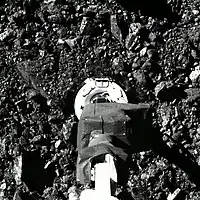TOI-700 d
TOI-700 d is a near-Earth-sized exoplanet, likely rocky, orbiting within the habitable zone of the red dwarf TOI-700, the outermost planet within the system. It is located roughly 101.4 light-years (31.1 pc) away from Earth in the constellation of Dorado. The exoplanet is the first Earth-sized exoplanet in the habitable zone discovered by the Transiting Exoplanet Survey Satellite (TESS).[3][4][5]
 Simulation of the planetary system of TOI-700 (center) and its habitable zone, with planet d orbiting within it. | |
| Discovery | |
|---|---|
| Discovered by | Emily Gilbert |
| Discovery date | 3 January 2020 |
| Transit | |
| Orbital characteristics | |
| 0.163±0.015 AU | |
| Eccentricity | 0.110+0.140 −0.079[1] |
| 37.4260+0.0007 −0.0010 d | |
| Inclination | 89.73+0.15 −0.12 deg |
| Star | TOI-700 |
| Physical characteristics | |
Mean radius | 1.19 ± 0.11 REarth[2] |
| Mass | ≙1.72+1.29 −0.63 MEarth[2] |
| Temperature | Teq: 268.8 K (−4.3 °C; 24.2 °F)[1] |
TOI-700 d orbits its star at a distance of 0.163 AU (24,400,000 km; 15,200,000 mi) from its host star with an orbital period of roughly 37.4 days, has a mass about 1.7 times that of Earth, and has a radius of around 1.19 times that of Earth. It has been estimated that the planet receives about 86% the energy that the Earth receives from the Sun.[6]
It was discovered in early January 2020 by the Transiting Exoplanet Survey Satellite (TESS).
Physical characteristics
Mass, radius and temperature
TOI-700 d is Earth-sized, an exoplanet that has a radius and mass similar to the Earth. It has an estimated mass of around 1.72 MEarth and a radius of about 1.12 REarth.[2] If it has an earthlike atmosphere, then its average temperature would be about 268.8 K (−4.3 °C; 24.2 °F).[1] A small chance of a runaway greenhouse effect exists.[7]
Host star
TOI-700 is a red dwarf of spectral class M that is about 40% the mass and radius, and very roughly 50% of the temperature of the Sun.[5] The star is bright with low levels of stellar activity. Over the 11 sectors observed with TESS, the star does not show a single white-light flare. The low rotation rate is also an indicator of low stellar activity.[2]
Orbit
TOI-700 d orbits its host star every 37.42 days.
Proposed habitability

TOI-700 d orbits in the habitable zone of its host star TOI-700. The solar wind ram pressure and intensity of the interplanetary magnetic field are expected to be similar to the Earth's, therefore retention of the planetary atmosphere is likely.[8][9]
History and discovery
TOI-700 d was discovered by the Transiting Exoplanet Survey Satellite (TESS) in early January 2020. This was the first Earth-sized exoplanet discovered by the TESS.[10]
See also
References
- Rodriguez, Joseph E.; Vanderburg, Andrew; Zieba, Sebastian; Kreidberg, Laura; Morley, Caroline V.; Kane, Stephen R.; Spencer, Alton; Quinn, Samuel N.; Eastman, Jason D.; Cloutier, Ryan; Huang, Chelsea X. (3 January 2020). "The First Habitable Zone Earth-Sized Planet from TESS. II: Spitzer Confirms TOI-700 d". The Astronomical Journal. 160 (3): 117. arXiv:2001.00954. Bibcode:2020AJ....160..117R. doi:10.3847/1538-3881/aba4b3. S2CID 209862553.
- Gilbert, Emily A.; Barclay, Thomas; Schlieder, Joshua E.; Quintana, Elisa V.; Hord, Benjamin J.; Kostov, Veselin B.; Lopez, Eric D.; Rowe, Jason F.; Hoffman, Kelsey; Walkowicz, Lucianne M.; Silverstein, Michele L. (3 January 2020). "The First Habitable Zone Earth-sized Planet from TESS. I: Validation of the TOI-700 System". The Astronomical Journal. 160 (3): 116. arXiv:2001.00952. Bibcode:2020AJ....160..116G. doi:10.3847/1538-3881/aba4b2. S2CID 209862554.
- Andreolo, Claire; Cofield, Calla; Kazmierczak, Jeanette (6 January 2020). "NASA Planet Hunter Finds Earth-Size Habitable-Zone World". NASA. Retrieved 6 January 2020.
- Garner, Rob (6 January 2020). "NASA Planet Hunter Finds Earth-Size Habitable-Zone World". NASA. Retrieved 6 January 2020.
- Wall, Mike (6 January 2020). "NASA's TESS Planet Hunter Finds Its 1st Earth-Size World in 'Habitable Zone'". Space.com. Retrieved 6 January 2020.
- "[VIDEO] TOI 700d : une planète de la taille de la Terre découverte dans une "zone habitable"". midilibre.fr (in French). Retrieved 17 April 2020.
- Suissa, Gabrielle; Wolf, Eric T.; Kopparapu, Ravi Kumar; Villanueva, Geronimo L.; Fauchez, Thomas; Mandell, Avi M.; Arney, Giada; Gilbert, Emily A.; Schlieder, Joshua E.; Barclay, Thomas; Quintana, Elisa V.; Lopez, Eric; Rodriguez, Joseph E.; Vandenburg, Andrew (1 July 2020). "The First Habitable Zone Earth-sized Planet from TESS. III: Climate States and Characterization Prospects for TOI-700 d". The Astronomical Journal. 160 (3): 118. arXiv:2001.00955. Bibcode:2020AJ....160..118S. doi:10.3847/1538-3881/aba4b4. S2CID 209862275.
- Cohen, O.; Garraffo, C.; Moschou, S.; Drake, J.; Alvarado-Gomez, J.; Glocer, A.; Fraschetti, F. (2020). "The Space Environment and Atmospheric Joule Heating of the Habitable Zone Exoplanet TOI 700 D". The Astrophysical Journal. 897 (1): 101. arXiv:2005.11587. Bibcode:2020ApJ...897..101C. doi:10.3847/1538-4357/ab9637. S2CID 218869952.
- Dong, Chuanfei; Jin, Meng; Lingam, Manasvi (2020). "Atmospheric Escape from TOI-700 d: Venus versus Earth Analogs". The Astrophysical Journal. 896 (2): L24. arXiv:2005.13190. Bibcode:2020ApJ...896L..24D. doi:10.3847/2041-8213/ab982f. S2CID 219558481.
- "NASA's TESS Planet Hunter Finds Its 1st Earth-Size World in 'Habitable Zone'". 7 January 2020.
External links
- TESS – Official WebSite
- ExoFOP TIC 150428135 TOI-700 in the Exoplanet Follow-up Observing Program website



_on_Jul_14_2020_aligned_to_stars.jpg.webp)